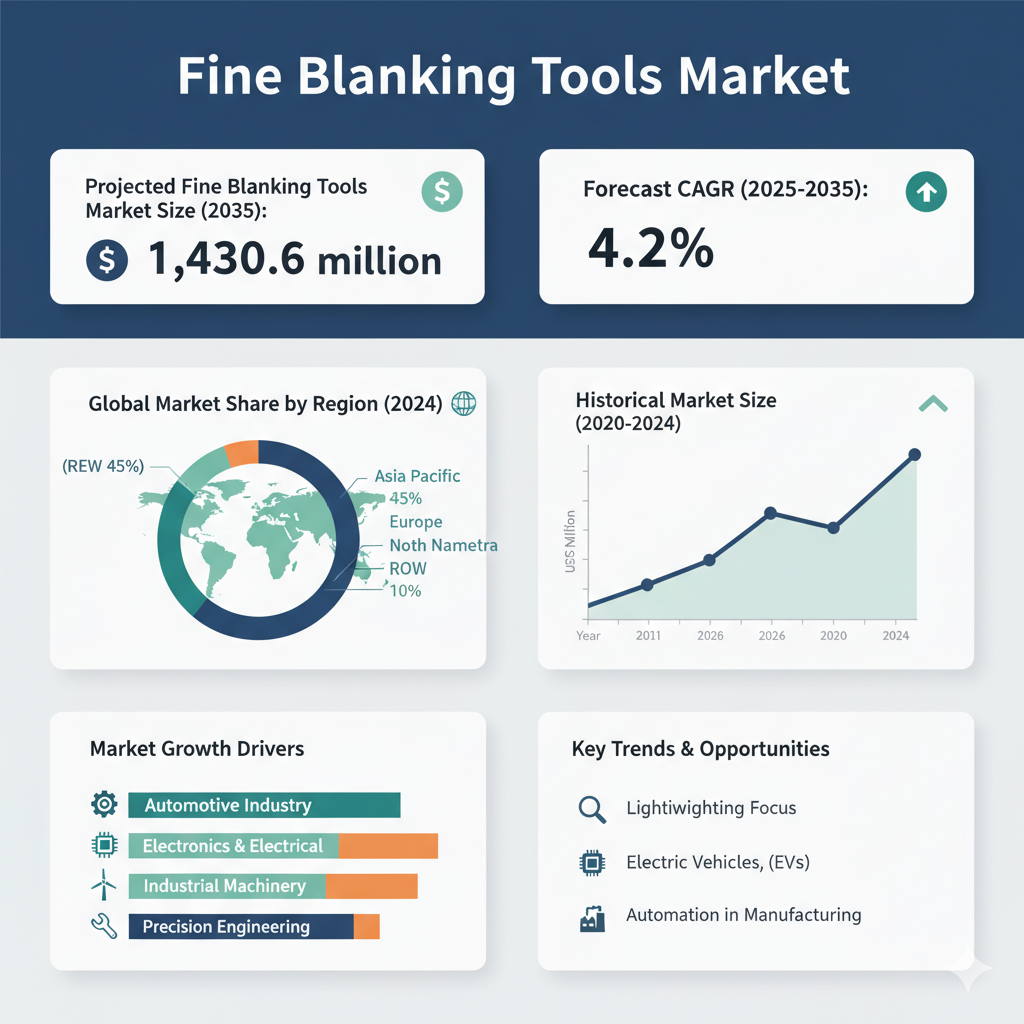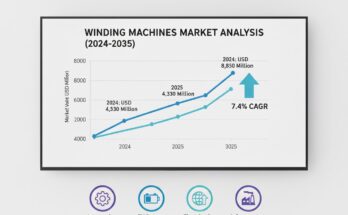Market Size & Growth Projection
The global fine blanking tools market is projected to increase from USD 948.1 million in 2025 to USD 1,430.6 million by 2035, registering a compound annual growth rate (CAGR) of 4.2% during the forecast period. This growth reflects the expanding role of fine blanking tooling in precision manufacturing and its vital contribution to high-performance component production across diverse industries.
Market Segmentation by Industry
The fine blanking tools market serves multiple end-use industries, including electrical, automobile, construction, precision machinery, oil & gas, and aviation. Among these, the automobile sector remains the dominant segment, primarily driven by the increasing demand for precision-engineered components and the transition toward electric and hybrid vehicles. Fine blanking technology plays a critical role in producing safety components, seatbelt parts, and transmission systems that require extremely tight tolerances.
The electrical industry is also demonstrating robust growth, fueled by the rapid evolution of compact electronic devices and the growing need for precision connectors and switchgear components. Meanwhile, the construction and oil & gas industries are incorporating fine blanking tools for producing durable fittings and structural components, while the aviation and precision machinery sectors depend on these tools for high-accuracy parts and assemblies that can withstand heavy mechanical stress.
Market Segmentation by Type
By type, the market is broadly categorized into sliding-punch and fixed-punch fine blanking tools. The sliding-punch variant currently commands a larger market share due to its versatility in producing complex geometries and its suitability for large-scale, high-precision applications. It allows for smooth, clean cuts with minimal deformation, which is essential for critical automotive and aerospace parts.
The fixed-punch segment, on the other hand, is gaining traction for its cost-effectiveness and reliability in producing simpler, repetitive components. As industries continue to focus on cost optimization and efficiency, demand for fixed-punch systems is expected to grow at a steady pace, particularly among small and medium-scale manufacturers.
Market Segmentation by Die Type
Based on die configuration, the fine blanking tools market is segmented into progressive die, fine blanking die, and single die systems. Progressive dies hold a substantial share due to their ability to perform multiple operations in one setup, reducing cycle time and improving productivity. Fine blanking dies, characterized by their ultra-precise performance, are widely used in the automotive and aerospace industries. Single dies, while simpler in structure, remain significant for specialized, low-volume production where precision and customization are essential.
Regional Outlook
Geographically, the market spans North America, Latin America, Europe, East Asia, South Asia & Pacific, and the Middle East & Africa. The Asia-Pacific region has emerged as the fastest-growing hub, supported by rapid industrialization, rising automotive production, and an expanding electronics manufacturing base in countries such as China, India, Japan, and South Korea.
Europe and North America continue to be key regions, driven by advanced manufacturing ecosystems and strong demand from established automotive and aerospace industries. Europe’s precision engineering standards, particularly in Germany and Switzerland, contribute significantly to technological advancements in fine blanking. North America, with its growing focus on automation and industrial innovation, remains a mature yet steadily expanding market.
Recent Developments and Competitive Landscape
Recent years have witnessed several notable developments that are reshaping the fine blanking tools industry. Leading manufacturers are increasingly focusing on innovation in tool materials, such as the introduction of advanced tool steels, carbide coatings, and hybrid composites that enhance tool durability and reduce wear. Additionally, the integration of automation and Industry 4.0 technologies—such as real-time monitoring, robotic handling, and data-driven process control—has improved productivity and consistency in fine blanking operations.
The transition toward electric vehicles has also spurred the need for advanced fine blanking solutions capable of manufacturing lightweight, high-precision components for electric motors and battery systems. Companies are investing in new designs and materials tailored to the unique requirements of the EV sector, which promises to be a major growth avenue in the coming decade.
Several global players are expanding their production capacities and setting up new facilities, particularly in Asia-Pacific, to meet rising OEM and aftermarket demand. Key players in the market include TIDC India, IFB Industries Limited, Petford Group, ART Group, Ferrari & Carena S.r.l., Quantum Manufacturing Limited, Kenmode Precision Metal Stamping, and Menear Engineering. These companies are focusing on enhancing precision, extending tool life, and offering customized fine blanking solutions. Strategic collaborations, mergers, and technology partnerships with OEMs are also becoming increasingly common as companies seek to strengthen their competitive positions.
Challenges and Strategic Insights
Despite the positive growth outlook, the fine blanking tools market faces certain challenges. High initial investment costs and complex maintenance requirements often deter smaller manufacturers from adopting fine blanking technology. Additionally, the shortage of skilled labor capable of operating and maintaining precision tooling systems can hinder efficiency. Competition from alternative manufacturing methods such as laser cutting and stamping also poses a challenge, particularly for less precision-critical applications.
Looking ahead, manufacturers and tool suppliers are expected to focus on improving cost-efficiency, expanding automation capabilities, and developing service-based business models that reduce total ownership costs for customers. Expanding into emerging markets, strengthening die design expertise, and maintaining close partnerships with OEMs will be crucial for long-term competitiveness.
Conclusion
The fine blanking tools market is on a promising growth trajectory, driven by global industrialization, the rise of electric mobility, and the increasing need for precision-engineered components. With the market expected to reach USD 1,430.6 million by 2035, industry players who embrace technological innovation, material advancement, and regional diversification are well-positioned to capitalize on emerging opportunities. The next decade will likely see fine blanking tools becoming even more integral to high-precision manufacturing worldwide.



